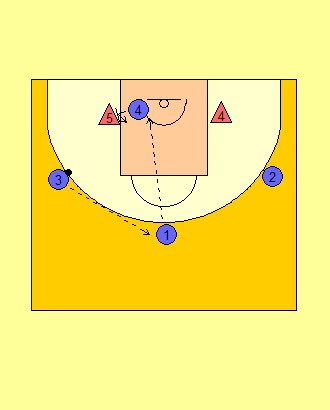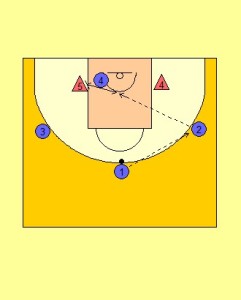Ball Reversal to Score Drill

The Ball Reversal to Score Drill looks to help players develop the set of technical skills needed as well as offensive awareness to be able to score in the post from ball rotation on the perimeter. As players become more and more athletic they become more aggressive and intense in defence. Defenders in the modern game ae very active and will look to challenge an offensive player’s position more readily than at any other time in the sport’s history. Post players now find themselves needing to be woven into a team’s offense and not simply being a catch and attack unit in isolation. Playing off the ball for an offensive player now becomes very important in setting up for or creating the right offensive situation. The Ball Reversal to Score Drill looks to highlight these skills off the ball which lead to scoring opportunities.
The Ball Reversal to Score Drill starts with three offensive players around the perimeter. Two players are at the wings (Two and Three) while another is positioned at the Point Position (One).

Another offensive player (Four) starts in the keyway. The aim of the drill for this player to receive a pass and score within the normal rotation of the ball from one side of the floor to the other.
To aid in challenging the offensive player two defensive players (Triangles Four and Five) are positioned in the low post on either side of the keyway.
Defenders look to front the offensive post and not allow themselves to be cut over or under.
The focus of the Ball Reversal to Score Drill is for the player to recognise this high energy challenge by the defender and and not try to fight for position, instead use what is given by the defence and wait for ball rotation and a good seal to lead to a scoring opportunity.
The drill will start with the post player (Four) under the basket and a cost pass the ball to a player on the floor. Four (4) will look to move towards the wing where the ball was passed and wait for the desired ball rotation.
The defenders will look to front Four (4).
In some cases on the first pass of the ball reversal from the wing (Three) to the top of the three-point line (One) the post player will maintain contact and simply look to place their body between the defender and the passing lane.
Alternatively, the offensive player may need to break off contact before the pass is made from the wing, and then re-seal as this situation unfolds and ball is rotated.
Defenders should continue to implement defensive principles while guarding the post player until Four (4) crosses the split line and into the other defenders area of responsibility.
The Ball Reversal to Score Drill is live until the offensive player (Four) scores or the defender secures possession/rebound.
The next opportunity for the score will happen as the ball is reversed to the opposite wing position.
The Four (4) will look to hold an existing seal or create a new one and flash to the ball as the pass is initiated by Two (2) from the wing.

In some instances within the Ball Reversal to Score Drill the ball can be reversed quickly from one side of the floor to the other. While the perimeter players need to be aware of what opportunity is inside, in a game this will regularly happen and a post player must practice maintaining a seal until the ball is passed into them. The ball should be passed between the offensive player (Four) and the basket. Not directly at the post player, but rather leading the player to the basket.
Post players should be able to initate and hold their seal for the two passes to be performed in shifting the ball from one side of the floor to the other.
Remember also that the Ball Reversal to Score Drill is challenging for those players on the perimeter as well. Passing into the post can be very difficult for players who have never really had the tactical situation explained to them. This learning curve can also be steep and require some time for it to be developed.
Variations
To help in making the Ball Reversal to Score Drill more effective there are some options to consider which help change the drill’s progression.
If an offensive post player is struggling with footwork or maintaining their seal, consider replacing the two defenders with cones until the player can become more competent of maintaining balance and positioning. Once the player understands the basic movements then look to remove one cone and replace with a defender. A focus should always be during this transition on footwork and the offensive player controlling their body. Finally, add the second defender by removing the last cone.
Because of the complexity of the movement off the ball, the Ball Reversal to Score Drill can have many players taking part with only one really as the focus. Alleviate this issue by adding defenders to match-up against the perimeter players. To Help in implementing this added complexity, add a defender to the Point Position first so there is one defender playing against this player only. Later, add two further defenders to the wing positions.
It is suggested to add the defender to the middle position first, as this playing role on the perimeter will take the longest to master. The player in the Point Position is vital for both passing a ball into the keyway and reversing the ball. Secondly, positioning of this defender still allows a skip pass to occur so the drill will not fully stall if the middle perimeter player cannot find space to make a catch.
The final variation suggested is to allow the offensive player in the post (Four) to challenge more significantly the defender trying to front them. This will see the offensive player being more aggressive in trying to get in front of the defender initially, before utilising the skills described earlier, which are the main focus of the Ball Reversal to Score Drill.
The Ball Reversal to Score Drill looks to create a scenario where players can develop a range of skills related to scoring away from where the ball is heading. These subtleties in the game of basketball for post players are how they continue to tick over their points totals while not needing to be the focus of the team’s offense constantly. Effective post players can make-up half of their points from this type of action in a game.

